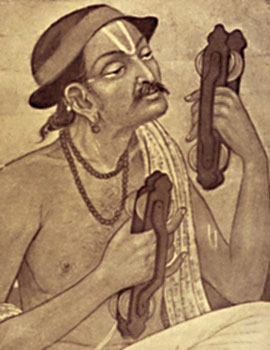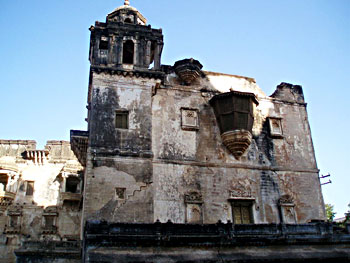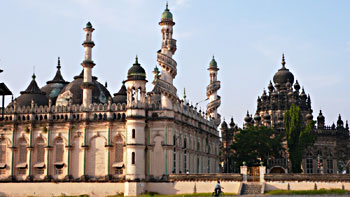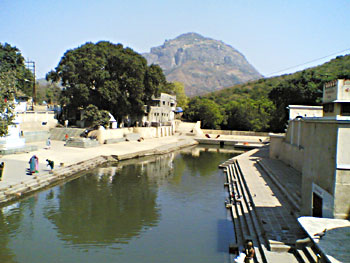 There are a number of historical monuments scattered all over Junagadh in Gujarat. The monuments of Junagadh mainly incorporate forts. There are two forts found in the fortified town of Junagadh. For instance, the Uparkot fort lies to the north-east of town. This massive fort was built in the 4th century on the edge of a plateau. The fort is an ancient stronghold of the Maurya and Gupta Empires. It is alleged that for over 300 years, between the 7th and 10th centuries, the fort was abandoned to the jungle, but after rediscovery it was reused and strengthened. Over its long history since 976 it has endured no less than sixteen sieges. The approach is through solid rock and via three gateways with massive walls. Over the entrance is carved an inscription of 1450. The top of the old fort is flat and crossed by pathways linking the principal sites.
There are a number of historical monuments scattered all over Junagadh in Gujarat. The monuments of Junagadh mainly incorporate forts. There are two forts found in the fortified town of Junagadh. For instance, the Uparkot fort lies to the north-east of town. This massive fort was built in the 4th century on the edge of a plateau. The fort is an ancient stronghold of the Maurya and Gupta Empires. It is alleged that for over 300 years, between the 7th and 10th centuries, the fort was abandoned to the jungle, but after rediscovery it was reused and strengthened. Over its long history since 976 it has endured no less than sixteen sieges. The approach is through solid rock and via three gateways with massive walls. Over the entrance is carved an inscription of 1450. The top of the old fort is flat and crossed by pathways linking the principal sites.
A number of monuments are found situated inside the fort. The Jami Masjid is found within the fort, built from the remains of a former Hindu Temple. The Tomb of Nuri Shah lies close to the mosque and may be recognized by the fluted cupolas and ornate carving over the door. A huge step-well is situated here, known as the Adi Chadi Vav. It has over 172 steps, and has been named after two slave girls. A similar well, the Navghan Kuva is also found within. It is believed to have been constructed sometime in 1060. It is over 170 feet and can be reached by means of a splendid, circular staircase.
 On the western wall are two colossal guns. The larger of the two, the Nilam, cast in Egypt in 1531, is over 17 ft long, with a bore of 25 cm. The smaller, the Chudanal, is 12 ft 8 in long. They were left at Diu by Sulaiman Pasha, the Turkish Admiral, to help the Sultan against the Portuguese in 1538 and were later brought here by the Fouzdar of Junagadh. Nearby are a number of ancient Buddhist caves, over 1,500 years old, cut into the soft rock of the hillside. Some of the caves are from the time of Ashoka.
On the western wall are two colossal guns. The larger of the two, the Nilam, cast in Egypt in 1531, is over 17 ft long, with a bore of 25 cm. The smaller, the Chudanal, is 12 ft 8 in long. They were left at Diu by Sulaiman Pasha, the Turkish Admiral, to help the Sultan against the Portuguese in 1538 and were later brought here by the Fouzdar of Junagadh. Nearby are a number of ancient Buddhist caves, over 1,500 years old, cut into the soft rock of the hillside. Some of the caves are from the time of Ashoka.
The remains of another fort are also found here. The town is surrounded by an old fort wall, part of which has now been demolished to facilitate growth. The fort was expanded in 1472 by Mahmud Begada, and enlarged later again in 1683 and 1880.
The city palace near Uparkot dates from 1870 AD and is a fine piece of architecture. The Durbarhall of the palace is now a museum which tries to showcase the 19th century Nawabi Junagadh. Found here are a fine collection of items dating to the Nawabi period. These include silver-plated thrones, huge chandeliers, howdahs and palanquins, lavishly embroidered and richly adorned carpets studded with gems, ancient paintings and portraits, turtle shell shields, swords, daggers etc.
 A significant group of architectural constructions is found here in the form of the mausolea of the rulers of Junagadh. These Maqbaras are richly ornamented sepulchers of an exuberant design from the eighteenth century. The tombs are adorned with vertical columns, delicate carved arches, cornices and domes in a range of sizes, the whole accentuated by a wealth of brilliant stone carvings.
A significant group of architectural constructions is found here in the form of the mausolea of the rulers of Junagadh. These Maqbaras are richly ornamented sepulchers of an exuberant design from the eighteenth century. The tombs are adorned with vertical columns, delicate carved arches, cornices and domes in a range of sizes, the whole accentuated by a wealth of brilliant stone carvings.
From the north gate the first tomb is that of Nawab Bahadur Khan II (1840), which lies to the left. Adjacent is the Tomb of Nawab Hamid Khan II (1851) and to its left, that of Laddibu Bibi. Beside these is the tomb of Mahabat Khan I (1774), in Saracenic style with fine carved detail. The spectacular tomb of Vizir Sahib Baha-ud-Din Bhar has minarets with spiral stairs curling round in a fantastic display of architectural ebullience.
The Naya Maqbara complex which was started in 1878 by Mahabat Khanji is even more impressive. It was completed by his successor Bahadur Khanji in 1892. This complex contains the tomb of Rasul Khanji and of his minister Baha-ud-din. The mausoleum of the latter has 4 minarets with pirouetting spiral staircases, a fa‡ade with rich stone carvings, large sized domes and beautiful silver domes. Located close to the Maqbara is the Jama mosque, dated 1886. It has a cool marble minars with seven rows of colored pillars leading up to it. There is an Islamic religious school here too.
 The Ashokan edicts situated on the way from Junagadh to Girnar, have been constructed by Emperor Ashoka himself. It serves as a veritable source of information about the history of Gujarat and the Mauryan dynasty. The fourteen edicts of Ashoka have been inscribed on a great big boulder. The inscription is in the Pali language of the Brahmi script. They convey certain universal religious principles such as self control, secular thinking etc, and also depict the devastations caused by war.
The Ashokan edicts situated on the way from Junagadh to Girnar, have been constructed by Emperor Ashoka himself. It serves as a veritable source of information about the history of Gujarat and the Mauryan dynasty. The fourteen edicts of Ashoka have been inscribed on a great big boulder. The inscription is in the Pali language of the Brahmi script. They convey certain universal religious principles such as self control, secular thinking etc, and also depict the devastations caused by war.
The Nawab`s Old Palace (t. 1870), which contains the Rasaul Khanji Museum (1925), is opposite the Haveli and Durbar Kacheri Hall. The Aina Mahal or Palace of Mirrors lies to the east, with a fine Gothic range to one side of the entrance.
The Narsi Mehta No Choro is another great architectural site in Junagadh. It is said to be the place where the great poet and reformer Narsi Mehta held his assemblies and discourses in the fifteenth century.
The city also has a remarkable collection of heritage buildings which combine European Gothic with exotic local forms in a riotous mixture of styles bordering on the decadent.
The Reay Gate is a large, arcaded, two-storey crescent with a central clock-tower and an engrailed entrance arch, capped by domes and minarets.
Within the town are numerous fine local buildings. The New Bazaar is an elegant classical terrace leading to huge Gothic gateways.
The monuments of Junagadh exhibit great variety in terms of construction and architectural styles mainly due to the reign of varied dynastic rule here.



















